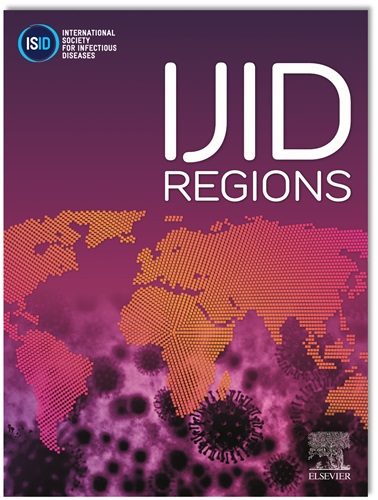First report of a fatal case of Clostridium porci bacteremia in an 8-month-old girl presenting with purpura fulminans associated with concurrent Yersinia pseudotuberculosis infection
IF 4.8
2区 医学
Q1 INFECTIOUS DISEASES
引用次数: 0
Abstract
Objectives
Yersinia pseudotuberculosis rarely causes bacteremia, and Clostridium porci, an obligate anaerobic bacterium identified as part of the intestinal microbiota in pigs, has not been reported to cause human infection. We report an infant with VACTERL association who developed purpura fulminans. Upon transfer to our hospital, the patient went into shock. Laboratory findings revealed elevated inflammatory markers (white blood cell count of 25.3 × 109/L and serum C-reactive protein level of 4.02 mg/dL), coagulopathy suggestive of disseminated intravascular coagulation (prothrombin time-international normalized ratio of 1.38 and plasma D-dimer level of 7.4 µg/dL), and decreased plasma protein C activity (28%). Despite the intensive care, the patient died 55 h after admission.
Methods
Gram-positive and Gram-negative bacilli were isolated from blood samples and bacterial 16S rRNA gene sequencing was performed.
Results
Bacterial 16S rRNA gene sequencing identified as C. porci and Y. pseudotuberculosi.
Conclusions
Y. pseudotuberculosis rarely causes bacteremia and C. porci infection in humans is reported for the first time. Since Y. pseudotuberculosis can cause bacteremia, the bacteria should be cultured under conditions that allow Y. pseudotuberculosis to grow when patients with gastrointestinal diseases go into shock. In addition, a detailed analysis of C. porci, including its pathogenicity, is necessary because it can cause severe infections.
首例致命病例的猪梭菌菌血症在一个8个月大的女孩呈现与并发假结核耶尔森菌感染相关的暴发性紫癜。
假结核耶尔森氏菌很少引起菌血症,而猪梭菌是一种专性厌氧细菌,被确定为猪肠道微生物群的一部分,尚未报道引起人类感染。我们报告了一例与VACTERL相关的婴儿,由于同时感染假结核杆菌和C. porci而发展为暴发性紫癜。病人一转到我们医院,就休克了。实验室结果显示炎症标志物升高(白细胞计数25.3 × 109/L,血清C反应蛋白水平4.02 mg/dL),提示弥散性血管内凝血的凝血功能紊乱(凝血酶原与国际标准化比值为1.38,血浆d -二聚体水平为7.4µg/dL),血浆蛋白C活性降低(28%)。从血样中分离到革兰氏阳性杆菌和革兰氏阴性杆菌,经细菌16S rRNA基因测序鉴定分别为猪链球菌和假结核杆菌。尽管进行了重症监护,患者在入院后55小时死亡。由于假结核杆菌可引起菌血症,因此当胃肠道疾病患者休克时,细菌应在允许假结核杆菌生长的条件下培养。此外,对porci的详细分析,包括其致病性,是必要的,因为它可以引起严重的感染。
本文章由计算机程序翻译,如有差异,请以英文原文为准。
求助全文
约1分钟内获得全文
求助全文
来源期刊
CiteScore
18.90
自引率
2.40%
发文量
1020
审稿时长
30 days
期刊介绍:
International Journal of Infectious Diseases (IJID)
Publisher: International Society for Infectious Diseases
Publication Frequency: Monthly
Type: Peer-reviewed, Open Access
Scope:
Publishes original clinical and laboratory-based research.
Reports clinical trials, reviews, and some case reports.
Focuses on epidemiology, clinical diagnosis, treatment, and control of infectious diseases.
Emphasizes diseases common in under-resourced countries.

 求助内容:
求助内容: 应助结果提醒方式:
应助结果提醒方式:


